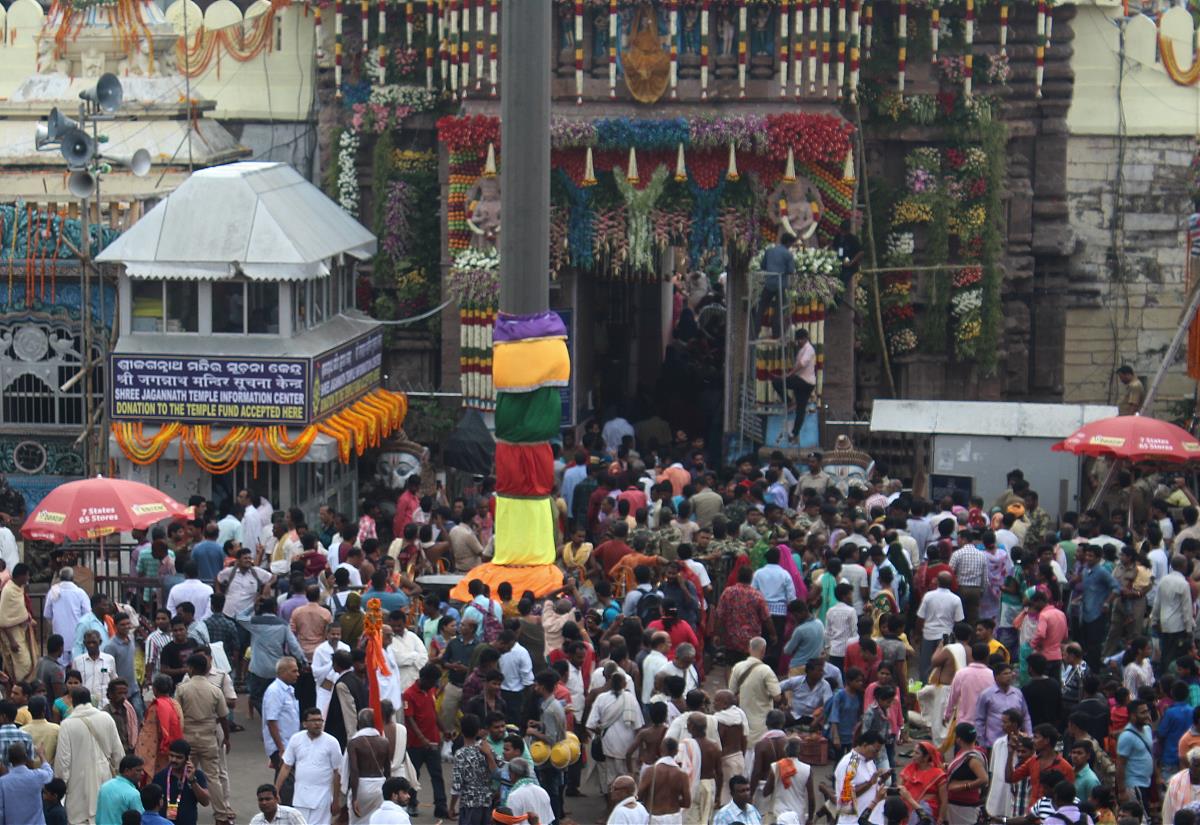The Simha dwara, or the Lion Gate, is one of the four gates to the temple of Shree Jagannath and forms the main entrance. It is named so because two colossal statues of crouching lions carved in a naturalistic style, with crowns on their heads exist on either side of the entrance. The gate faces east opening on to the bada danda or the Grand Road. The Lion Gate is square in structure and built with a pyramidal roof. Its door- frames are of black chlorite and most beautifully carved. The statues of the two guards to the temple Jaya and Vijay doorway. Just before the commencement of the Ratha Yatra (car festival), the idols of Jagannath, Balabhadra and Subhadra are taken out of the stand on either side of the temple through this gate. On their return from the Gundicha Temple they have to ceremonially placate Goddess Mahalakshmi, whose statue is carved atop the door, for neglecting to take Her with them on the Ratha Yatra. Normally, the devotees enter into the temple through this gate.

In the propylaeum at the Lion’s Gate on the northern side or to the right as a devotee enter the temple there is an idol of Jagannath

known means the “saviour or as patita pavana, whideliverer of the downtrodden and the fallen”, In front of the image of patita pavana, a small image of Garuda has been installed. This patita pavana image of Jagannath, however, is different from the main deity of Jagannath. This image of Jagannath (patita pavana) is by Himself and not with His brother Balabhadra or sister Subhadra or with His sudarshan chakra. The deity has manifested only a face, with
no arms or torso. Some scholars say that Jagannath manifested Himself to give darshana to His devotee Salabega, who was born in a Muslim family while others claim that Jagannath manifested here to give darshana to His devotee Gajapati king of Khurdha, Ramachandra Deva II who was converted to Islam and was not allowed to enter the temple. However, it is generally believed that during the medieval period, the untouchables who were not allowed to go inside the temple used to offer their prayers to patitapavana (Jagannath) remaining outside the simha dwara. Even now, it is believed that if one cannot go inside the temple, the same benefit of darshana simply by presenting oneself before the all-compassionate patita can get pavana Jagannath. On the left side of the enclosure, on a long stone pedestal stands the image of Hanumana, thickly smeared with vermilion, as the guard of the temple and the patita pavana Jagannath.

Apart from the simha dwara, which is the main entrance to the temple, there are three other entrances facing south, west and north. They are named after the sculptures of animals guarding them such as the ashwa dwara or the horse gate on the south, the vyaghra dwara or the khanja-dwara or the tiger gate on the west and the hathi dwara or the elephant gate simha dwara, the ashwa dwara, the vyaghra dwara and the hathi dwara are also respectively called purva dwara, dakshina dwara, paschima dwara and uttara dwara according to their directions. Each gate located at the central part of the walls. The gates are crowned with pyramid shaped structures. Worshipping of the gates also forms a part of the daily ritualistic are services of the temple. Navagraha reliefs carved on the architraves of all the gates. In almost all the gates there are small images of Shiva, Vishnu, Hanumana, Durga and Nrusimha. According to a local tradition, the four gates represent chaturvarga (four vargas) i.e, dharma (lion), artha (elephant), kama (horse) and moksha (tiger). According to another tradition these four gates symbolize the four fundamental principles of dharma (right conduct), jnana (knowledge), vairagya (renunciation) and aishwarya (prosperity) in the direction of east south, west and north respectively. According to K.C.Mishra “The Lord Jagannatha being the monarch, is supposed to live in His imperial abod-which is necessarily a fort consisting of four gate in its four sides.” He further says that these four gates i.e., simha dwara, ashwa dwara, vyaghr dwara and hathi dwara represents the strength military prowess, energy and prosperity of the monarch i.e. of Shree Jagannath respectively.

